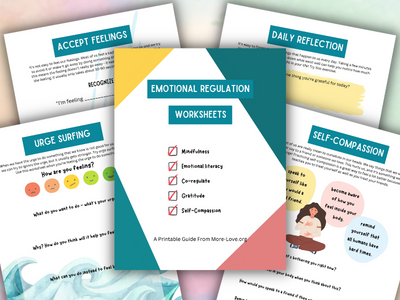
by Jennifer Kreatsoulas, PhD, RYT
One challenge for adolescents recovering from an eating disorder like anorexia, bulimia or binge eating disorder is even wanting to be in their bodies in the first place. I say this with complete and sincere understanding of how intolerable it can be to live in the body. I know the depth of self-loathing and disgust. I also know the fatal lengths one will go to shrink, hide, numb, and escape existing in their body. I’ve been there.
Yoga helped me experience my body as a source of strength rather than a heavy burden to endure. By learning how to breathe deeply, stay present, and open my mind to possibilities versus limitations, yoga showed me how to be present to my thoughts about my body and challenge them in real time. I had a choice: hate myself or learn how to use my body to ground my mind and fill up with a kinder feeling than disgust.
Emotional Regulation Worksheets
Give these printable worksheets to grow more confident, calm and resilient and feel better, fast!
- Self-Esteem
- Self-Regulation
- Mindfulness
- Calming strategies
No doubt, this is hard work. It takes vigilance and diligence. But, I’ve seen in myself and my yoga therapy clients that small shifts are very possible when we take a risk and call on our bodies to cultivate empowerment and centeredness.
I think it’s a great idea to try some basic yoga as a family or one-on-one with your child who has an eating disorder, and tree pose is a great way to start. Tree pose improves balance and coordination while inviting calm and steadiness. As a balancing pose, tree may help your child learn to respond to feeling in balance and off balance.
Here is a video showing how to do tree pose:
My clients have taught me some creative ways to use their bodies in tree pose to calm spinning and obsessive thoughts and cultivate centeredness. Here are a few variations you can also try.
Two Feet for Grounding
Take tree pose with one foot on the floor and the other resting as a kickstand at your ankle or placed above or below your knee (just now next to your knee joint to stay safe in the pose). Ground your standing foot into the floor by pressing firmly down through the four corners of your feet. Allow all your toes to relax instead of grip. Just as firmly, press your other foot into your leg, being mindful not to force or push too hard. By rooting with both feet, your tree pose will grow taller. You also send a message to your mind that you are steady, focused, and centered. You may hold your hands in prayer at your heart, open your arms by your sides, or reach them above your head. Hold this pose for as many breaths as is comfortable and then switch sides. And if you fall out, no big deal. You can choose to switch to the other side or continue the same side.
Seated Tree
Sit upright. Begin with both feel on the floor. Pause and notice that your feet are grounded on the floor even though your mind feels like the complete opposite. Draw one foot up to any part of your leg. And, like we did above, use both of your feet for grounding. Press into the floor and your leg and allow your mind to rest on the sensations in both feet. Notice your breathing, and purposefully bring it to a steady natural rhythm and you hold the grounded sensation in your body through your feet. You can bring your hands into the mix by resting them on your lap or on the table, creating four points of groundedness.
Emotional Regulation Worksheets
Give these printable worksheets to grow more confident, calm and resilient and feel better, fast!
- Self-Esteem
- Self-Regulation
- Mindfulness
- Calming strategies
Tree on a yoga block
Grab a yoga block and begin standing with both feet on the block. Once you feel steady, take tree pose. Start with your foot resting against your ankle as a kickstand and notice your balance. If you feel steady, you might explore drawing your foot above or below your knee. Test out your balance. Find that place where you can be centered in the pose to allow your mind a few purposeful moments to rest. You may hold your hands in prayer at your heart, open your arms by your sides, or reach them above your head. Hold this pose for as many breaths as is comfortable and then switch sides. And if you fall out, no big deal. You can choose to switch to the other side or continue the same side.
Partner tree variation
Stand side to side with your tree pose partner, facing the same way, about 1 to 2 feet from each another. Hold hands of your inside arms and bring the foot of your outside legs into tree. Holding hands, reach your arms up (the outside arms too). Have fun finding the steady point for the both of you and explore how using each other for support helps to find balance in the pose. Hold for a 5 breaths or so and then switch sides.
The idea is to take a playful attitude when practicing yoga with your teenager with an eating disorder. You may be surprised how soothing it can be for your child to move his or her body in a new way and use the body to calm the mind. It’s in those moments of calm that we can work together to catch glimpses of new perspectives and begin to form a new relationship with our bodies.

Jennifer Kreatsoulas, PhD, E-RYT 200, RYT 500, is a yoga teacher and yoga therapist specializing in eating disorders and body image. In recovery herself, Jennifer is extremely passionate about helping others reconnect with their bodies and be empowered in their lives. Jennifer works with clients in person and via Skype. She also teaches yoga at the Monte Nido Eating Disorder Center of Philadelphia and is a partner with the Yoga and Body Image Coalition. She leads trauma-sensitive yoga classes and teaches weekly flow yoga classes. Jennifer contributes regularly to eating disorder and body image blogs and the YogaLiving Magazine. Website

